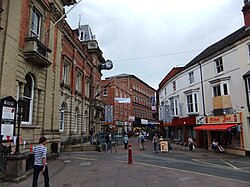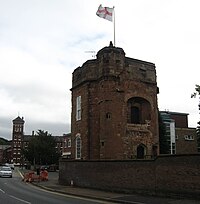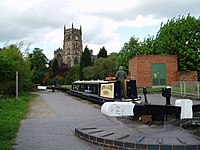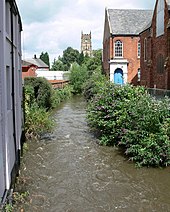Kidderminster
| Kidderminster | |
| Worcestershire | |
|---|---|
 Vicar Street, Kidderminster | |
| Location | |
| Grid reference: | SO831767 |
| Location: | 52°23’19"N, 2°14’56"W |
| Data | |
| Population: | 55,348 |
| Post town: | Kidderminster |
| Postcode: | DY10, DY11 |
| Dialling code: | 01562 |
| Local Government | |
| Council: | Wyre Forest |
| Parliamentary constituency: |
Wyre Forest |
Kidderminster is a town in Worcestershire, fifteen miles north of Worcester city centre and some seventeen miles south-west of Birmingham city centre. The 2001 census gave it a population of 55,182.
The River Stour and the Staffordshire and Worcestershire Canal both pass through Kidderminster town centre.
Contents
Name
The earliest written form of the name Kidderminster is in the Domesday Book of 1086, in which it is recorded as Chedeminstre. Various spellings appear in later centuries: Kedeleministre or Kideministre (in the 12th and 13th centuries), Kidereministre (13th–15th centuries) – until the name of the town was settled as Kidderminster by the 16th century.[1]
History
The nucleus of what was to become the town of Kidderminster was the village of Stour-in-Usmere, whose name may derive from the Husmerae, an Anglo-Saxon folc mentioned in the Ismere Diploma, a document in which Ethelbald of Mercia granted a "parcel of land of ten hides" to Cynebehrt.[2] Stour-in-Usmere was later the subject of a territorial dispute settled by Offa of Mercia in 781, where he restored certain rights to Bishop Heathored,[1] which allowed for the creation of a monastery or minster in the area. This was the foundation of Kidderminster, though the name is not recorded until the Domesday Book, which records Chedeminstre as a large manor held by the King, with 16 outlying settlements (Bristitune, Fastochesfeld, Franche, Habberley, Hurcott, Mitton, Oldington, Ribbesford, Sudwale, Sutton, Teulesberge, Trimpley, Wannerton and Wribbenhall).
Between 1156 and 1162, Henry II granted the manor to his steward, Manasser Biset, and as the settlement grew a fair (1228) and later a market (1240) were established there.[1] In a visit to the town at some time around 1540, King's Antiquary John Leland noted that Kidderminster "standeth most by clothing".[1] King Charles I granted the Borough of Kidderminster a Charter in 1636.[1]
A parliamentary report of 1777 listed Kidderminster Borough as having a parish workhouse accommodating up to 70 inmates. Under the Relief of the Poor Act of 1782, Kidderminster Union was established for the purpose of relieving the indigent poor.
Kidderminster has two Commissioners' churches. The first was St. George's Church, on Radford Avenue. This was designed by Francis Goodwin and built in 1821–1824,[3] finally being consecrated in April 1824. It had the third largest grant by the Commission, of just over £17,000.00, of any church outside London.[4] The second church was St John's church, on the Bewdley Road. This church was built in 1843 and the architect was Matthew Steele, although the grant in this case was just over £4,000.[4]
To the south by the River Stour, dating from the 15th century, is a single surviving tower of Caldwall (or Caldwell) Castle, a fortified manor house.[5]
Economy
The modern carpet industry was founded in the area in 1785 by Brintons, and the carpet industry became extremely important to the local economy, so much so that the local newspaper is still named The Shuttle after the shuttles used on the carpet looms. Although much declined in recent years, the industry is still a significant employer in the area; Brintons Carpets still employ several hundred people and is one of the biggest employers in the town. Kidderminster is also the home of Victoria Carpets plc.
With the opening of the commercial retail area of "Weaver's Wharf" in March 2004, the town centre area had been substantially redeveloped, attracting well know chain stores. 'Slingfield Mill', a Grade II listed building, houses a clothing shop. Shopping is not confined to one high street but enjoys a wider commercial centre.
Solid-fuel rocket motors are manufactured in Summerfield on the outskirts of Kidderminster on the Roxel site where the motors for the Rapier missile, Seawolf missile, Starstreak and ASRAAM missile systems were manufactured. The site has had several owners including IMI, Royal Ordnance and British Aerospace, and is now part of the Roxel Group, headquartered in Paris and with a sister site outside Bordeaux.
The Sealine yacht company manufactures boats for the luxury market and is Kidderminster's second-largest single employer.
Prominent on the edge of the town are the two storage silos sited on the former British Sugar Corporation site on the Stourport Road, which can be seen from the Malvern Hills, nearly thirty miles away.
Sport
- Cricket: Kidderminster Victoria CC
- Football: Kidderminster Harriers FC, formed in 1886
- Judo: Samurai Judo Club
- Rugby: Kidderminster Carolians RFC
- Field Hockey: Kidderminster Hockey club, founded in 1892
Theatre
- The Rose Theatre, with its resident company "The Nonentities".
- Kidderminster Operatics & Dramatics Society was founded in 1916 and is affiliated to the National Operatic and Dramatic Association. The Society used to be known as Kidderminster Amateur Operatic Society (KAOS) and performed at the Playhouse.
- Carpet Trades Operatic Society was founded in 1945 and is also affiliated with the National Operatic and Dramatic Association.
Media
- Radio: The Wyre and Wyvern FM
References
- ↑ 1.0 1.1 1.2 1.3 1.4 http://www.british-history.ac.uk/report.aspx?compid=43103
- ↑ John Blair, The Church in Anglo-Saxon Society (New York, Oxford University Press, 2005)
- ↑ The Buildings of England: Worcestershire, Nikolaus Pevsner, 1968 Penguin. p206
- ↑ 4.0 4.1 A History of Kidderminster, Nigel Gilbert, 2004 Phillimore. p89 and p102
- ↑ "Caldwall Castle". britishlistedbuildings.co.uk. http://www.britishlistedbuildings.co.uk/en-156422-caldwall-hall-kidderminster. Retrieved 2011-03-08.
Further reading
- Burton, John Richard (1890). A history of Kidderminster, with short accounts of some neighbouring parishes. London: E. Stock. http://www.archive.org/details/historyofkidderm00burt.
Outside links
- Wyfopedia, on-line encyclopaedia for the Wyre Forest district
- Parish church
- Kidderminster Workhouse
- Carpet Museum Trust
- The Rose Theatre
- River Stour
- S&W Canal
- Boys' Brigade The 1st Kidderminster Boys' Brigade Company
- Exploring Roxel Rocket Site, Wyre Forest
- Newspapers:
- Kidderminster news - Express & Star
- The Shuttle Local Kidderminster weekly newspaper
- Radio stations:


